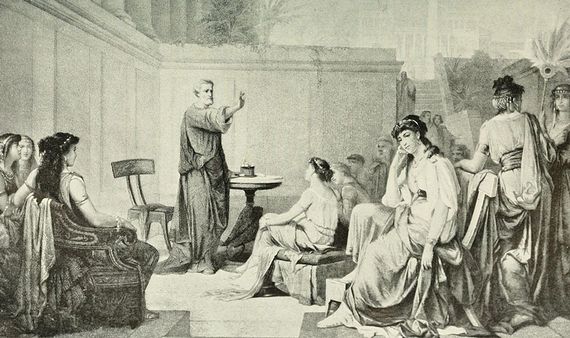Music can be considered an anthropological universal – something that is found without exception in each and every culture, even if the way in which it is conceived and felt varies around the world.
Origins and humanism
The emergence of music is most likely connected to language, but what is certain is that it began with the use of the body, the voice and the discovery of onomatopoeias prior to the use of rudimentary instruments such as stones.
Western music originated and is closely tied to the rational, logical thought that was introduced by the Greeks, who also laid the foundations of humanism. The Greeks did not have a system and theory for the arts like that which currently exists, whose roots were proposed by Kant in his Critique of Judgment in 1790. The philosopher and mathematician Pythagoras (born in Samos, Greece, 580 AC) epitomized Greek musical theory, establishing the main laws for music based on numbers.

Although it was with Ars Nova (14th Century) when music grew in technique, unity and expressiveness, even leading to a school of thought in France and some parts of Spain, like Aragon. It was Ars subtilior, a state of the art school at the time that based its concept of representation on a technique that was able to graphically solve sound problems. The scores were in the shape of hearts or circles and even added some colors in the notation. The works of Baude Cordier are an example of this. These movements led to the development of a “doctrine of the affections” in later years, which entailed studying the rules in order to obtain the more varied effects in listeners, provoking emotions and effectively interpreting the musical texts. This theory even influenced Claudio Monteverdi (1567-1643). Starting from this time, music was required to be expressive and create emotions that go beyond the superficial and static. The representativeness of the nature of human beings returned, whose feelings it attempted to express, together with the events of nature. An idea that would reappear in the Baroque (where the mimetic implication and musical rhetoric made it possible to delve into the representation technique). It would again be picked up by Romanticism, which also considered that music not only had great emotional capacity, but could also could express itself, thus making human beings’ feelings, emotions and passions flourish.

Soundscapes
By the end of the 20th Century, composers used mathematical models like fractal mathematics, and physics models like chaos theory to create their compositions, thus recovering an approach to nature – a spin on how it was represented. Raymond Murray Schafer (Canada, 1933) was one of the main pioneers of the concept of soundscapes and of work with natural sound. In 1977, he published his book (The Tuning of the World), where he laid out his theory on sound ecology and further developed the concept. In 1981, he also composed the opera The Princess of the Stars, in which the soundscape was the main character, as the opera was to be performed by a lake, as far as possible from populated places, and had to begin shortly before dawn in order to incorporate the sounds from the sun rise in the opera.

Source: Unsplash
Therefore, it is clear that the soundscape is holistic, incorporates visual, olfactory and tactile elements…. and this trend proposed by Schafer has led to trends such as sound art, in which musicians have included sounds from cities or factories in their compositions, using them as musical material. There is also something called sound ecology in which elements of nature join elements of music. Most of Toru Takemitsu’s (Tokyo, Japan, 1930-1996) formal concepts were closely connected to his visual imagery, based on painting, in the dream universe and in his perception of traditional Japanese gardens. And he conceived the music he composed for films as a new sound color that feeds off of the images while becoming part of the movie. Tan Dun (Hunan, China, 1957), better known for winning an Oscar for the soundtrack of Crouching Tiger, Hidden Dragon (released in Spain in 2001) and the composer of the music for the 2008 Olympic Games in Beijing, uses paper and water, purely natural elements as sources of sound that become percussion instruments in his compositions. His productions are both visual and philosophical. The paper elements/instruments are made with white colors and the water elements/instruments use transparent materials in order to capture the natural beauty while making these sounds influence the orchestra.
Music will always be a part of human beings’ lives. It’s important to remember that educating the senses and thus expanding the way we perceive what surrounds us should be one of the main goals of art.
References
- Grout, D. J., y Palisca, C. V. (1999): Historia de la música occidental. Volumes 1 and 2. Madrid. Alianza editorial.
- Marco, T. (2008): Historia cultural de la música. Madrid. Ediciones Autor (Fundación Autor).
- Michels, U. (2004): Atlas de Música. Volumes 1 y 2. Madrid. Alianza editorial.
- Pitágoras (1997 edition): Los versos de oro. Argentina. Editorial Troquel.
- Zapico, P. (2015, 2017, 2018): Técnica de rasgueado. Volumes 1, 2 y 3. Numbers 21, 23, 24. Revista Hispanica Lyra. Madrid. Sociedad de la Vihuela.
Comments on this publication